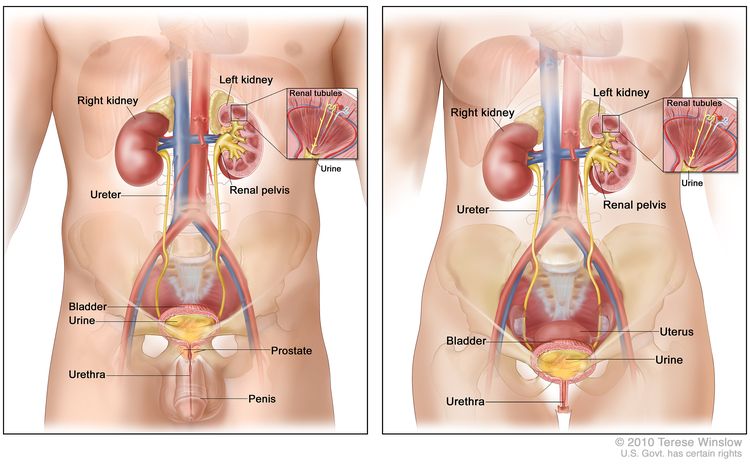Bladder and Other Urothelial Cancers Screening (PDQ®)–Patient Version
What is screening?
Screening is looking for cancer before a person has any symptoms. This can help find cancer at an early stage. When abnormal tissue or cancer is found early, it may be easier to treat. By the time symptoms appear, cancer may have begun to spread.
Scientists are trying to better understand which people are more likely to get certain types of cancer. They also study the things we do and the things around us to see if they cause cancer. This information helps doctors recommend who should be screened for cancer, which screening tests should be used, and how often the tests should be done.
It is important to remember that your doctor does not necessarily think you have cancer if he or she suggests a screening test. Screening tests are given when you have no cancer symptoms.
If a screening test result is abnormal, you may need to have more tests done to find out if you have cancer. These are called diagnostic tests.
General Information About Bladder and Other Urothelial Cancers
KEY POINTS
- Bladder and other urothelial cancers are diseases in which malignant (cancer) cells form in the urothelium.
- Bladder cancer is more common in men than women.
- Smoking can affect the risk of bladder cancer.
Bladder and other urothelial cancers are diseases in which malignant (cancer) cells form in the urothelium.
The bladder is a hollow organ in the lower part of the abdomen. It is shaped like a small balloon and has a muscle wall that allows it to get larger or smaller to store urine made by the kidneys. There are two kidneys, one on each side of the backbone, above the waist. Tiny tubules in the kidneys filter and clean the blood. They take out waste products and make urine. The urine passes from each kidney through a long tube called a ureter into the bladder. The bladder holds the urine until it passes through the urethra and leaves the body.
The urothelium is a layer of tissue that lines the urethra, bladder, ureters, prostate, and renal pelvis. Cancer that begins in the urothelium of the bladder is much more common than cancer that begins in the urothelium of the urethra, ureters, prostate, or renal pelvis. Because it is the most common form of urothelial cancer, bladder cancer is the focus of this summary.

There are 3 types of cancer that begin in the urothelial cells of the bladder. These cancers are named for the type of cells that become malignant (cancerous):
- Transitional cell carcinoma: Cancer that begins in cells in the innermost layer of the bladder urothelium. These cells are able to stretch when the bladder is full and shrink when it is emptied. Most bladder cancers begin in the transitional cells.
- Squamous cell carcinoma: Cancer that forms in squamous cells (thin, flat cells that line the bladder). Cancer may form after long-term infection or irritation.
- Adenocarcinoma: Cancer that begins in glandular cells. Glandular cells in the bladder urothelium make substances such as mucus.
See the following PDQ summaries for more information about bladder and other urothelial cancers:
Bladder cancer is more common in men than women.
In the United States, bladder cancer occurs more often in men than in women, and more often in whites than in blacks. Rates of bladder cancer have stayed about the same since the 1970s, although more recently (2008 to 2017), bladder cancer rates have been decreasing slightly each year. Deaths from bladder cancer decreased in all races and sexes between 1975 and 2017.





















.png)












No hay comentarios:
Publicar un comentario